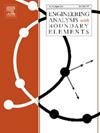A novel weak-form meshless method based on Lagrange interpolation for mechanical analysis of complex thin plates
IF 4.2
2区 工程技术
Q1 ENGINEERING, MULTIDISCIPLINARY
Engineering Analysis with Boundary Elements
Pub Date : 2024-11-06
DOI:10.1016/j.enganabound.2024.106021
引用次数: 0
Abstract
In this paper, a novel weak-form meshless method, Galerkin Free Element Collocation Method (GFECM), is proposed for the mechanical analysis of thin plates. This method assimilates the benefits of establishing spatial partial derivatives by isoparametric elements and forming coefficient matrices node by node, which makes the calculation more convenient and stable. The pivotal aspect of GFECM is that the surrounding nodes can be freely chosen as collocation elements, which can adapt to irregular node distribution and suitable for complex models. Meanwhile, each collocation element is used as a Lagrange isoparametric element individually, which can easily construct high-order elements and improve the calculation accuracy, especially for high-order partial differential equations such as the Kirchhoff plate bending problem. In order to obtain the weak-form of the governing equation, the Galerkin form of the governing equation is constructed based on the virtual work principle and variational method. In addition, due to the Lagrange polynomials possessing the Kronecker delta property as shape functions, it can accurately impose boundary conditions compared with traditional meshless methods that use rational functions. Several numerical examples are proposed to verify the correctness and effectiveness of the proposed method in thin plate bending problems.
基于拉格朗日插值的新型弱形式无网格法,用于复杂薄板的力学分析
本文针对薄板的力学分析,提出了一种新颖的弱形式无网格方法--Galerkin 自由元素配位法(GFECM)。该方法吸收了等参数元素建立空间偏导数和逐节点形成系数矩阵的优点,使计算更加方便和稳定。GFECM 的关键之处在于周围节点可自由选择作为配位元素,能适应不规则的节点分布,适用于复杂模型。同时,每个配位元单独作为一个拉格朗日等参数元,可以方便地构造高阶元,提高计算精度,尤其适用于高阶偏微分方程,如 Kirchhoff 板弯曲问题。为了得到控制方程的弱形式,基于虚功原理和变分法构建了控制方程的 Galerkin 形式。此外,由于拉格朗日多项式作为形状函数具有 Kronecker delta 特性,与使用有理函数的传统无网格方法相比,它能精确施加边界条件。本文提出了几个数值实例,以验证所提方法在薄板弯曲问题中的正确性和有效性。
本文章由计算机程序翻译,如有差异,请以英文原文为准。
求助全文
约1分钟内获得全文
求助全文
来源期刊

Engineering Analysis with Boundary Elements
工程技术-工程:综合
CiteScore
5.50
自引率
18.20%
发文量
368
审稿时长
56 days
期刊介绍:
This journal is specifically dedicated to the dissemination of the latest developments of new engineering analysis techniques using boundary elements and other mesh reduction methods.
Boundary element (BEM) and mesh reduction methods (MRM) are very active areas of research with the techniques being applied to solve increasingly complex problems. The journal stresses the importance of these applications as well as their computational aspects, reliability and robustness.
The main criteria for publication will be the originality of the work being reported, its potential usefulness and applications of the methods to new fields.
In addition to regular issues, the journal publishes a series of special issues dealing with specific areas of current research.
The journal has, for many years, provided a channel of communication between academics and industrial researchers working in mesh reduction methods
Fields Covered:
• Boundary Element Methods (BEM)
• Mesh Reduction Methods (MRM)
• Meshless Methods
• Integral Equations
• Applications of BEM/MRM in Engineering
• Numerical Methods related to BEM/MRM
• Computational Techniques
• Combination of Different Methods
• Advanced Formulations.
 求助内容:
求助内容: 应助结果提醒方式:
应助结果提醒方式:


